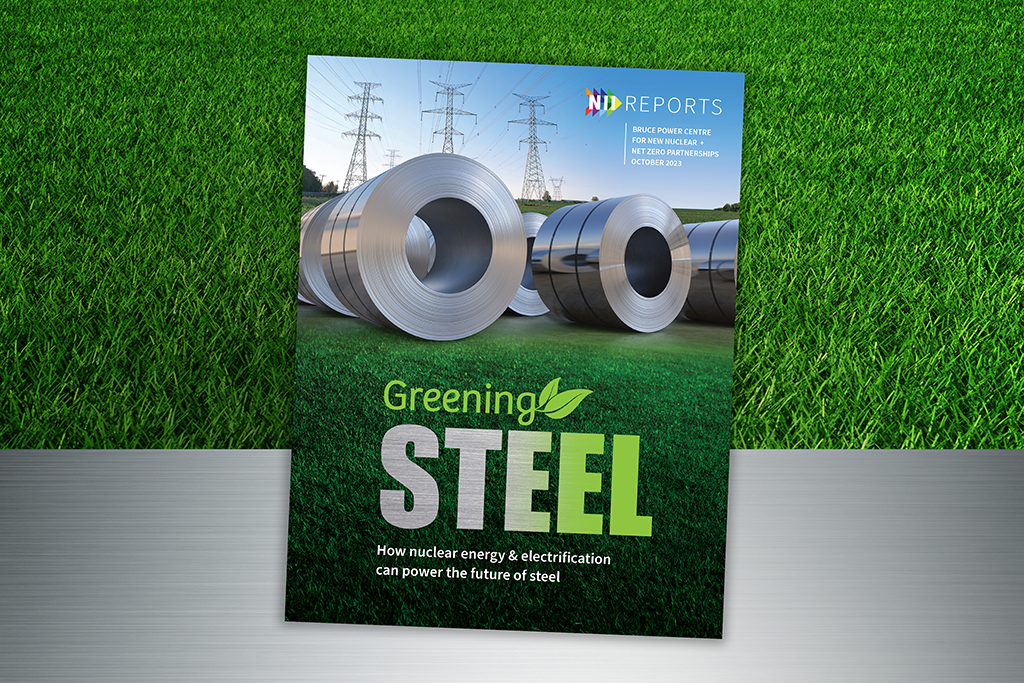Canada’s steel industry is one of the greenest in the world, thanks to carbon-free electricity generated by nuclear power, including the strong baseload supply from Bruce Power. And as Canadian steelmakers look to further decarbonize their processes over the coming years, the demand for clean electricity is demonstrating the need for clean, reliable, affordable nuclear power.
A report released today, Greening Steel: How nuclear energy and electrification can power the future of steel, shows that on average, Canadian steelmakers expect to see a 430 per cent increase in electricity demand by 2050 as they transition to processes powered by electricity and expand operations. The report, jointly produced by the Bruce Power Centre for New Nuclear & Net Zero Partnerships at the Nuclear Innovation Institute and the Canadian Steel Producers Association (CSPA), report highlights the increased demand from the Canadian steel sector for clean electricity in the decades ahead and demonstrates how nuclear can meet this demand.
“Nuclear can provide the clean, reliable, and affordable electricity supply to power a transition to widespread green steelmaking, starting in Ontario and across Canada as provincial grid operators look at adding and expanding nuclear in their supply mix,” said Pat Dalzell, Executive Director, Corporate Affairs at Bruce Power.
“As the generator of 30 per cent of Ontario’s carbon-free electricity, and through the successful completion of our Major Component Replacement projects and continued asset optimization, Bruce Power is committed to providing the long-term supply of clean power needed to further decarbonize Canada’s steel industry, and other sectors. This report further proves there is no path to net zero without nuclear.”
In developing this report, NII surveyed CSPA members about their priorities, emissions reduction plans and expectations for future electricity demand. All respondents stated that if the current policy landscape remains, their company anticipates using an increased amount of electricity from the grid to meet their emissions reduction goals.
The Canadian steel industry has already made significant gains in decarbonizing their operations and by 2030, CSPA members are on track to have reduced their greenhouse gas (GHG) emissions by at least 45 per cent which meets and exceeds Canada’s 2030 target of 40 per cent GHG emissions reductions by 2030.
Additionally, steel manufacturers can offset Scope 2 emissions from their Ontario-based operations by purchasing clean energy credits (CECs) from Ontario clean energy generators, including nuclear operators such as Bruce Power, in order to achieve voluntary environmental targets. Companies looking to offset their emissions can purchase the CEC, which is an electronic certificate, and register it with the Ontario CEC Registry which facilitates the CEC transfer. Bruce Power’s CECs are created from its investment in new and incremental nuclear generation output through asset optimization and its Life-Extension Program.
About Bruce Power
Bruce Power is an electricity company based in Bruce County, Ontario. We are powered by our people. Our 4,200 employees are the foundation of our accomplishments and are proud of the role they play in safely delivering clean, reliable, nuclear power to families and businesses across the province and cancer-fighting medical isotopes around the world. Bruce Power has worked hard to build strong roots in Ontario and is committed to protecting the environment and supporting the communities in which we live. Formed in 2001, Bruce Power is a Canadian-owned partnership of TC Energy, OMERS, the Power Workers’ Union and The Society of United Professionals. Learn more at www.brucepower.com and follow us on Facebook, Twitter, LinkedIn, Instagram and YouTube.
For further information, please contact: John Peevers – 519-386-3799 – john.peevers@brucepower.com


